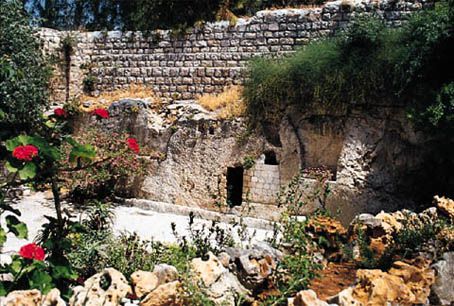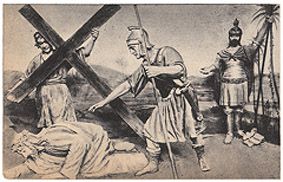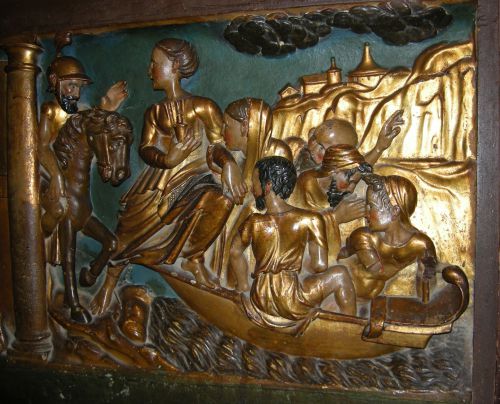Petronius, Roman friend of Mary and Jesus
The Soldier Called Petronius
Was the soldier trying to help Jesus in this Station of the Cross?
Centurians and other Roman soldiers appear in the Bible Gospels during the crucifixion story, but are not named. However, Petronius is named in the Gospel of St. Peter, an alternative gospel. See www.earlychristianwritings.com This gospel of Peter is known as a "passion narrative" that is, one of a crop of documents that appeared around 50AD describing the Crucifixion, still known as "the passion of Christ" in the Roman Church.
You may remember, from the article about Capernaum, that Petronius helped the people build the synagogue in which Jesus started preaching in 27AD, and Petronius later came to Jesus asking him to cure his sick boy, which Jesus did. There is no doubt that they are friends. Petronius was not named in the Bible Gospels, but scholars believe he was the same centurian.
My editorial eye sees the Gospels as real pieces of emotional writing; people of the day would have read the passion narratives as you or I might read a novel. There's no doubt that intense interest in Jesus continued after his apparent death and disappearance, and no doubt that any writer worth his salt, in the last first, second and third centuries, would have consulted his available sources and put together his own idea of events.
Experts on early Christian documents compare them in this way, to see who took what from whom. The Gospel of Peter shows no knowledge of the material in the four gospels of the New Testament. This implies the Gospel of Peter is independent, written about 50AD when passion narratives became popular.
Did Peter himself write it? Well, he wrote other things that appeared among the Gnostic gospels of Nag Hammedi. But the only copy we have of his Gospel is a Greek copy found in 1886 at Oxyrhynchus, in the tomb of a monk, copied by Cerinthus. The Gospel of Peter minimised Jesus's sufferings, implying he felt no pain because he was somehow divine. The Gospel of Peter reflected the "heresy" that Christ's body was not human but of Celestial substance, but is mainly interesting in that it absolves Pilate from responsibility for the crucifixion of Jesus, putting Pilate well on the way to the canonisation which he was to attain in the Coptic church.
The Coptic church was founded by St. Mark around 50AD, so the fact that Pontius Pilate, and his wife Claudia Procula, were canonised because they tried to help Jesus has a ring of truth, however extraordinary, about it.
Petronius is mentioned in the Gospel of St. Peter, in fact the most obvious difference between this and the other gospels is the name of Petronius. The regular gospels probably called Petronius simply "the centurian" to make him anonymous and protect his name, as was done with many other characters.
Let's have a look at what it actually says in the Gospel of Peter.
After Joseph of Arimathea persuaded Pilate to let him take the body down after only three hours (when it generally took three days to die), then;
And he took the Lord, and washed him, and wrapped him in a linen cloth, and brought him into his own tomb, which was called the Garden of Joseph.
Then the Jews and the elders and the priests, perceiving what evil they had done to themselves, began to lament and to say, Woe for our sins: the judgement hath drawn nigh, and the end of Jerusalem. And I with my companions was grieved; and being wounded in mind we hid ourselves: for we were being sought for by them as malefactors, and as wishing to set fire to the temple. And upon all these things we fasted and sat mourning and weeping night and day until the sabbath.
You remember that Peter - "the rock" - was the one that denied Christ three times before the cock crew. All the disciples disappeared. It was just the three Marys that stood watching the crucifixion, but at some distance away. Indeed it would have been horrible to witness. The victims often fouled themselves with terror or sweated profusely; they cried out in their torments and the Roman soldiers merely played dice or told jokes about their women - it was everyday life for them, to watch people dying horribly for three days.
I believe it was Petronius who persuaded the passionate Mary Magdalene in particular, to stay a distance away, as it says in Mark's gospel. Religious pictures depict her at the foot of the cross, crying and washing Jesus's feet with her tears, and clinging to him in a sort of sexual rapture - it just wouldn't have been like that.
But the scribes and Pharisees and elders . . . were afraid and came to Pilate, beseeching him and saying, Give us soldiers, that we may guard his sepulchre for three days, lest his disciples come and steal him away, and the people suppose that he is risen from the dead and do us evil. And Pilate gave them Petronius the centurion with soldiers to guard the tomb. And with them came the elders and scribes to the sepulchre, And having rolled a great stone together with the centurion and the soldiers, they all together who were there set it at the door of the sepulchre; And they affixed seven seals, and they pitched a tent there and guarded it. And early in the morning as the sabbath was drawing on, there came a multitude from Jerusalem and the region round about, that they might see the sepulchre that was sealed.
As the soldiers kept guard two by two in a watch, there was a great voice in the heaven; and they saw the heavens opened, and two men descend from thence with great light and approach the tomb. And that stone which was put at the door rolled of itself and made way in part; and the tomb was opened, and both the young men entered in.

The Garden Tomb, Jerusalem - traditionally, this is where Jesus was laid.
When therefore those soldiers saw it, they awakened the centurion (Petronius) and the elders, for they too were hard by keeping guard; and, as they declared what things they had seen, again they see three men coming forth from the tomb, and two of them supporting one, and a cross following them.
They therefore considered one with another whether to go away and shew these things to Pilate. And while they yet thought thereon, the heavens again are seen to open, and a certain man to descend and enter into the sepulchre. When the centurion and they that were with him saw these things, they hastened in the night to Pilate, leaving the tomb which they were watching, and declared all things which they had seen, being greatly distressed and saying, Truly he was the Son of God.
Pilate answered and said, I am pure from the blood of the Son of God: but ye determined this. Then they all drew near and besought him and entreated him to command the centurion and the soldiers to say nothing of the things which they had seen: For it is better, say they, for us to incur the greatest sin before God, and not to fall into the bands of the people of the Jews and to be stoned. Pilate therefore commanded the centurion and the soldiers to say nothing.
And at dawn upon the Lord's day, Mary Magdalene, a disciple of the Lord, fearing because of the Jews, since they were burning with wrath, had not done at the Lord's sepulchre the things which the women are wont to do for those that die and for those that are beloved by them, took her friends with her and came to the sepulchre where he was laid.
And they feared lest the Jews should see them, and they said, Although on the day on which he was crucified we could not weep and lament, yet now let us do these things at his sepulchre.
They went and found the tomb opened, and coming near they looked in there; and they see there a certain young man sitting in the midst of the tomb, beautiful and clothed in a robe exceeding bright; who said to them, Wherefore are ye come? Whom seek ye? Him that was crucified? He is risen and gone. But if ye believe not, look in and see the place where he lay, that he is not here; for he is risen and gone away thither, whence he was sent. Then the women feared and fled.
Now it was the last day of the unleavened bread, and many were going forth, returning to their homes, as the feast was ended. But we, the twelve disciples of the Lord, mourned and were grieved: and each one, being grieved for that which was come to pass, departed to his home. But I, Simon Peter and Andrew my brother, took our nets and went to the sea; and there was with us Levi the son of Alphaeus.
Incredible! Peter and the other disciples WENT FISHING? Just after their beloved Jesus had apparently died and they were mourning? It MUST have been a true account, no-one would have said that unless it were true.
So what really happened?
We may never know the details, unless more hidden gospels are found that explain all, but my idea is this; If Petronius - "the army officer" - was there at the Crucifixion, how did he get there from Capernaum? Did Herod Antipas, who employed him, summon him to Jerusalem with his men because he was afraid of rioting? Leaving the profitable customs post on the Via Maris unguarded? It seems unlikely.
The Bible give us no time-scale for the events leading up to the Crucifixion, merely implies Jesus was arrested on the Thursday night and was tried twice and then crucified and was dead by mid-day the next day. In reality this would have taken about three days.
It seems to me that when Petronius in Capernaum heard that Jesus had been arrested in Jerusalem he came as quickly as he could, possibly down the Via Maris. He came to see if he could do anything at all to rescue the man he loved who had saved his boy's life; but he arrived too late.
He made Mary Magdalene and the other women move away to save them distress.
Petronius gave Jesus a drug on a sponge on the point of his sword or spear and Jesus lost consciousness. Then in legend the Roman Longinus pierced Jesus's side with his sword and Jesus was proved dead.
Petronius was there and saw Mary Magdalene's tears when she washed and prepared Jesus's body for the tomb. Did she look up and meet the eyes of Petronius who loved her and Jesus? And did he then offer to guard the tomb and gave the other men strong wine to make them sleep so that Jesus could escape?
And, a strange little coda to this story, in St. John 21: 2 - 5. Simon Peter, Thomas called the Twin, Nathanial from Cana, the sons of Zebedee, John and James, and two other disciples were all together. Simon Peter said to the others "I am going fishing." "We will come with you," they told him. They went out in the boat but that night they did not catch a thing. As the sun was rising, Jesus stood at the water's edge . . . then he asked them; "Young men, have you caught anything?" "Not a thing," they answered.
So Jesus told them what to do, and they caught so much fish the nets nearly broke, and on the shore was a charcoal fire and some bread, so they roasted some of the fish and they ate together.
It was as though Jesus had never been away.
I proved in my book, "Looking for Mary M" that Mary Magdalene was with Jesus at these events described in the last chapter of St. John, and later that she and Jesus escaped the Holy Land to come to the south of France. I think Petronius helped them escape.
In the picture above, it seems that Petronius is waving goodbye to Mary Magdalene, and she is looking back as though she didn't want to say goodbye to her old friend. Meanwhile, who are the two young men with beards?
For the last of these articles in the Holy Land series, click here.
Inscrivez-vous au site
Soyez prévenu par email des prochaines mises à jour
Rejoignez les 261 autres membres



